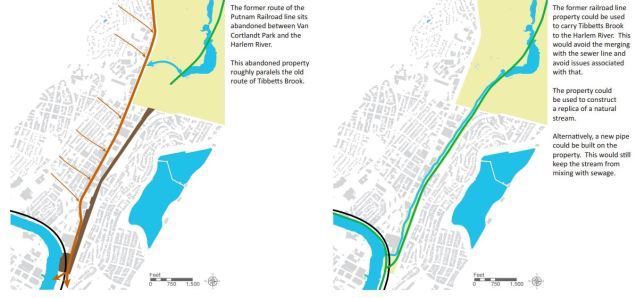Prior to urbanization, Tibbetts Brook flowed south from what is now Van Cortlandt Park to Spuyten Duyvil Creek, a course marked on maps by Tibbett Avenue. In the proposal to daylight the buried section of this stream, the new course is envisioned a few blocks to the east.

The proposed stream path runs on the route of a railway that rolled through northwestern Bronx until 1980. Since then, portions of it have become a naturally occurring wetland. With a little cleaning up and a path following it, one can imagine abandoned spaces such as the underpass above having a creek followed by a walking path.
Where it Flowed

According to the Wildlife Conservation Society’s Welikia Project, the historic path of Tibbetts Brook took the stream through the present-day Kingsbridge neighborhood towards its confluence with Spuyten Duyvil Creek, to the west of Marble Hill. The former stream bed is marked today by Tibbett Avenue. The path for the daylighted brook is a couple of blocks to the east, highlighted above.
 What’s There Today
What’s There Today
With the brook’s original course along Tibbett Avenue entirely covered by development, a few blocks to the east of Tibbett Avenue, there is a slim stretch of undeveloped and alongside the Major Deegan Expressway (Interstate 87) that holds out promise for a daylighted Tibbetts Brook.

Above, one can see an overpass of 238th Street that crosses the highway and the overgrown strip on its shoulder. Between 1881 and 1975, this was the New York & Putnam Railroad, which ran from 155th Street in Manhattan to Brewster in Putnam County. In contrast to the Hudson and Harlem lines that run through the Bronx, the Old Put, as this line was known, was not as successful in attracting passengers. Passenger service on the line ended in 1958 and freight service declined gradually until the line’s abandonment.
Within Van Cortlandt Park, two vestiges of the line are the trestle across Van Cortlandt Lake and the station canopy. An unpaved path runs atop the former rail line north to the city line, where it continues in Westchester County as the South County Trailway.
Reclaimed by Nature

A short section of the former rail line between Van Cortlandt Park South and Van Cortlandt Lake (where the pedestrian path begins) is thickly wooded with a moist surface where water collects after a heavy rain. Here, one can envision an elevated path above the ground and a brook draining out of the lake on its way south. A half century earlier, trains rolled through this landscape.

In other places, the former rail bed has become a naturally occurring wetland, not waiting for landscape architects to do their job.
Space for Revival

Although the site of the tracks is still owned by the freight rail company CSX, the underdeveloped parking lots alongside are ripe for development, with great demand for housing in this area. That reduces the width of the former rail line to three car lanes. Enough to fit a pedestrian path and a stream? Sure. New York is a creative city when it comes to parkland. We have the elevated High Line, there’s a subterranean Low Line park being proposed, and we have pocket parks sprinkled throughout the boroughs. So here’s to a mile-long park that ranges in width from approximately 12 feet to 60 feet.
How Will it Look?

Beneath the Van Cortlandt Park South overpass, the rail tracks were removed a long time ago and in their place is debris left by vagrants and illegal dumping. Graffiti covers whatever wall space is available. When the High Line in Manhattan became a park, the graffiti on walls along that line was buffed, giving the once-gritty surroundings a sanitized look. This being the Boogie Down Borough, I hope that a daylighted Tibbetts Brook course will celebrate graffiti as a Hall of Fame with works from local legends such as Tats Cru on display.
In the News:
News 12 Bronx reports on a new park corridor opening on the Bronx River.
Curbed NY reports on the proposed rezoning around Gowanus Canal in Brooklyn with affordable housing in mind.
WJLA reports no the upcoming restoration of the historic C&O Canal in Washington, D.C.


5 thoughts on “Bit of Tibbett on the Old Put”